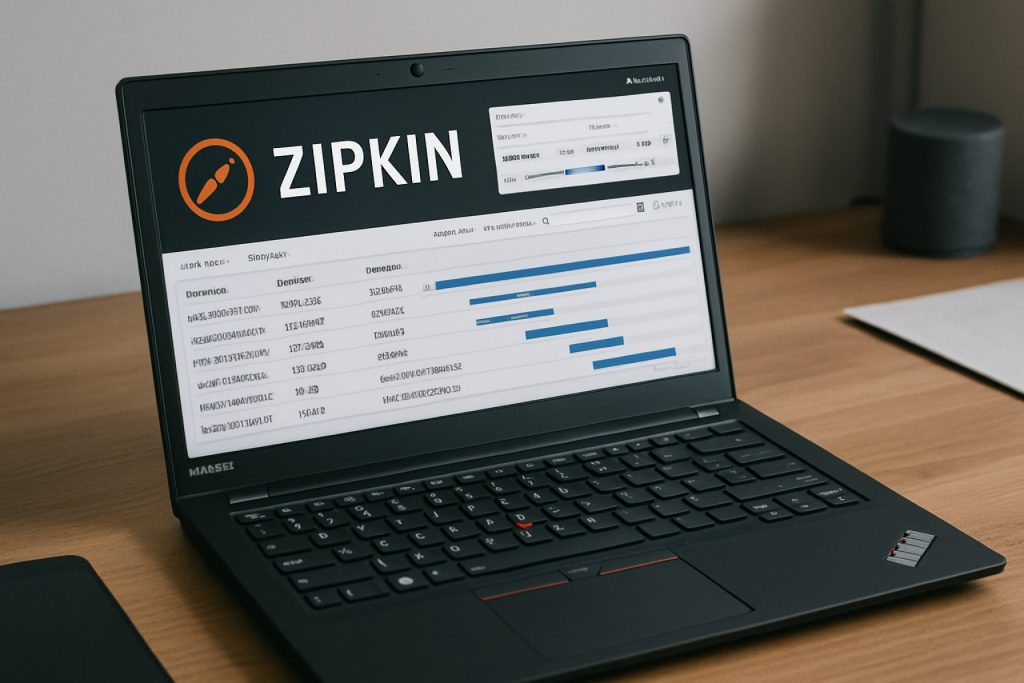
Mastering Distributed Tracing with Zipkin: How This Open Source Powerhouse Transforms Observability and Performance in Complex Architectures (2025)
- Introduction to Distributed Tracing and Zipkin
- Core Architecture and Components of Zipkin
- How Zipkin Integrates with Microservices Ecosystems
- Key Features and Capabilities of Zipkin
- Deployment Strategies: On-Premises, Cloud, and Hybrid
- Performance Impact: Real-World Use Cases and Benchmarks
- Security and Data Privacy in Zipkin Deployments
- Comparative Analysis: Zipkin vs. Other Tracing Solutions
- Market Trends and Adoption Forecast (2024–2028): 30%+ Annual Growth Expected
- Future Roadmap: Innovations and Community-Driven Enhancements
- Sources & References
Introduction to Distributed Tracing and Zipkin
Distributed tracing has become a cornerstone technology for monitoring, diagnosing, and optimizing complex microservices architectures. As organizations continue to migrate workloads to cloud-native environments and adopt container orchestration platforms, the need for end-to-end visibility across distributed systems has intensified. Distributed tracing addresses this challenge by capturing and correlating requests as they traverse multiple services, enabling engineers to pinpoint bottlenecks, latency issues, and failures with precision.
Zipkin is a prominent open-source distributed tracing system that originated at Twitter and is now maintained by a broad community under the stewardship of the Apache Software Foundation. Since its inception, Zipkin has played a pivotal role in shaping tracing standards and practices, offering a robust platform for collecting, storing, and visualizing trace data. Its architecture is designed to be language-agnostic, supporting a wide array of instrumentation libraries and integrations with popular frameworks and cloud platforms.
In 2025, Zipkin continues to be widely adopted by organizations seeking to enhance observability in their distributed systems. The system operates by instrumenting applications to generate trace data, which is then collected and processed by Zipkin’s backend components. This data provides a detailed view of request flows, service dependencies, and performance metrics, empowering teams to conduct root cause analysis and optimize service interactions.
Recent developments in the distributed tracing landscape have seen Zipkin align more closely with emerging standards such as OpenTelemetry, a project governed by the Cloud Native Computing Foundation (CNCF). OpenTelemetry provides a unified framework for collecting telemetry data, and Zipkin’s compatibility with its protocols and data formats ensures seamless integration into modern observability stacks. This interoperability is crucial as organizations increasingly adopt multi-cloud and hybrid cloud strategies, necessitating flexible and vendor-neutral tracing solutions.
Looking ahead, the outlook for Zipkin remains strong. The project benefits from active community contributions and ongoing enhancements aimed at improving scalability, storage efficiency, and user experience. As distributed systems grow in complexity, the demand for reliable, open-source tracing tools like Zipkin is expected to rise. Furthermore, the continued evolution of observability standards and the integration of artificial intelligence for automated anomaly detection are likely to shape the next generation of distributed tracing solutions, with Zipkin positioned as a foundational component in this ecosystem.
Core Architecture and Components of Zipkin
Zipkin is an open-source distributed tracing system designed to help developers monitor and troubleshoot latency issues in complex, microservices-based architectures. As of 2025, Zipkin remains a foundational tool in the observability ecosystem, widely adopted by organizations seeking to gain visibility into the flow of requests across distributed systems. Its architecture is intentionally modular, enabling integration with a variety of data sources, storage backends, and visualization tools.
At the core of Zipkin’s architecture are several key components:
- Instrumentation Libraries: These libraries are embedded within application code to collect trace data. They generate and propagate trace context (trace IDs and span IDs) as requests traverse service boundaries. Zipkin supports instrumentation for multiple programming languages, including Java, Go, Python, and JavaScript, ensuring broad compatibility across technology stacks.
- Collector: The collector is responsible for receiving trace data (spans) from instrumented applications. It supports multiple data transport protocols, such as HTTP and Kafka, allowing for flexible integration with diverse environments.
- Storage Backend: Zipkin’s storage layer is pluggable, supporting backends like MySQL, Cassandra, Elasticsearch, and in-memory storage. This flexibility allows organizations to scale Zipkin according to their data retention and query performance needs.
- Query Service: The query service provides APIs for retrieving and aggregating trace data from the storage backend. It enables users and external systems to search for traces based on criteria such as service name, operation, or time range.
- User Interface (UI): Zipkin’s web-based UI visualizes trace data, displaying the path of requests through microservices, highlighting latency bottlenecks, and enabling root cause analysis.
Recent developments in Zipkin’s architecture have focused on enhancing scalability, interoperability, and cloud-native deployment. The project has improved support for OpenTelemetry, the emerging standard for observability data, allowing Zipkin to ingest and export traces in OpenTelemetry formats. This positions Zipkin as a key player in the evolving observability landscape, where interoperability between tracing, metrics, and logging systems is increasingly important.
Looking ahead, the outlook for Zipkin in 2025 and beyond includes deeper integration with cloud-native platforms such as Kubernetes, improved support for high-throughput environments, and continued alignment with open standards. The project is maintained by a vibrant open-source community under the stewardship of The Apache Software Foundation, ensuring ongoing innovation and stability. As distributed systems continue to grow in complexity, Zipkin’s core architecture and components are expected to evolve to meet the demands of modern, large-scale applications.
How Zipkin Integrates with Microservices Ecosystems
Zipkin, an open-source distributed tracing system, has become a foundational tool for observability in microservices architectures. As organizations continue to adopt microservices to achieve scalability and agility, the need for robust tracing solutions like Zipkin has intensified. In 2025, Zipkin’s integration capabilities have evolved to address the growing complexity and heterogeneity of modern cloud-native environments.
At its core, Zipkin collects and visualizes trace data by instrumenting services to propagate context information (such as trace and span IDs) across process boundaries. This enables developers and operators to track requests as they traverse multiple microservices, pinpointing latency bottlenecks and failure points. Zipkin’s architecture is designed for flexibility: it supports multiple transport protocols (HTTP, Kafka, gRPC) and storage backends (Elasticsearch, Cassandra, MySQL, and more), making it adaptable to diverse infrastructure choices.
Integration with microservices ecosystems is facilitated through a rich set of client libraries and instrumentation agents available for popular programming languages, including Java, Go, Python, and JavaScript. These libraries are frequently updated to support the latest frameworks and runtime environments, ensuring seamless adoption in both legacy and greenfield projects. In Kubernetes environments, Zipkin is often deployed as a sidecar or as a centralized service, leveraging service meshes like Istio to automatically capture and forward trace data without requiring manual code changes.
A significant development in recent years is Zipkin’s alignment with the Cloud Native Computing Foundation (CNCF) ecosystem and its interoperability with the OpenTelemetry project. OpenTelemetry has emerged as the industry standard for observability instrumentation, and Zipkin natively supports ingesting OpenTelemetry traces, allowing organizations to standardize their tracing pipelines while benefiting from Zipkin’s visualization and analysis tools. This synergy is expected to deepen, with ongoing efforts to enhance compatibility and streamline migration paths.
Looking ahead, the outlook for Zipkin in microservices ecosystems remains strong. The project’s active community continues to prioritize scalability, performance, and ease of integration. As distributed systems grow in scale and complexity, Zipkin’s role as a lightweight, extensible tracing backend is likely to persist, especially in organizations seeking open-source, vendor-neutral observability solutions. Continued collaboration with CNCF projects and cloud providers will further cement Zipkin’s position as a key component in the observability stack for microservices architectures.
Key Features and Capabilities of Zipkin
Zipkin is an open-source distributed tracing system designed to help developers monitor and troubleshoot latency issues in complex, microservices-based architectures. As of 2025, Zipkin continues to be a foundational tool in the observability ecosystem, providing a robust set of features and capabilities that address the growing needs of cloud-native and distributed applications.
One of Zipkin’s core features is its ability to collect and visualize trace data across multiple services. By instrumenting applications with Zipkin-compatible libraries, developers can generate trace spans that capture timing, metadata, and context propagation as requests traverse through various microservices. This end-to-end visibility is crucial for diagnosing performance bottlenecks and understanding service dependencies.
Zipkin supports a variety of data ingestion methods, including HTTP, Kafka, and gRPC, making it adaptable to diverse deployment environments. Its storage backends are also highly configurable, with support for popular databases such as MySQL, Cassandra, Elasticsearch, and in-memory storage, allowing organizations to tailor Zipkin to their scalability and retention requirements.
A key capability of Zipkin is its user-friendly web interface, which enables users to search for traces by service, operation, or time window, and to drill down into individual trace details. The interface provides visualizations such as Gantt charts and dependency graphs, facilitating rapid root cause analysis and system optimization.
In recent years, Zipkin has enhanced its interoperability with other observability tools and standards. It offers native support for the OpenTelemetry project, which is governed by the Cloud Native Computing Foundation (CNCF), enabling seamless integration with a wide range of telemetry data sources and exporters. This alignment with OpenTelemetry ensures that Zipkin remains relevant as organizations increasingly adopt vendor-neutral observability solutions.
Security and scalability have also been areas of active development. Zipkin now provides improved authentication mechanisms and supports horizontal scaling to handle high-throughput environments, which is essential for large-scale enterprises and cloud-native platforms.
Looking ahead, the outlook for Zipkin is shaped by its active open-source community and its alignment with industry standards. Ongoing contributions focus on enhancing trace data enrichment, improving performance, and expanding compatibility with emerging cloud technologies. As distributed systems continue to proliferate, Zipkin’s role as a lightweight, extensible tracing solution is expected to remain significant in the observability landscape.
Deployment Strategies: On-Premises, Cloud, and Hybrid
As distributed systems continue to proliferate in 2025, organizations are increasingly focused on observability solutions that can adapt to diverse infrastructure needs. The Zipkin Distributed Tracing System, an open-source project originally developed by Twitter and now maintained by a broad community, remains a popular choice for tracing requests across microservices architectures. Its flexible deployment options—on-premises, cloud-native, and hybrid—allow organizations to tailor tracing strategies to their operational, security, and compliance requirements.
On-Premises Deployment of Zipkin is favored by enterprises with stringent data sovereignty or regulatory constraints. In this model, Zipkin is typically deployed alongside core application infrastructure within private data centers. Organizations leverage container orchestration platforms such as Kubernetes or traditional virtual machines to manage Zipkin’s components, including the collector, storage backend (often Elasticsearch or Cassandra), and the web UI. This approach provides maximum control over data residency and network security, but requires dedicated operational expertise for scaling and maintenance.
Cloud Deployment has gained significant traction, especially as cloud providers enhance their managed observability offerings. Zipkin can be deployed on major public clouds using container services or serverless platforms, integrating with cloud-native storage solutions like Amazon DynamoDB or Google Cloud Bigtable. This model reduces operational overhead and enables rapid scaling, making it attractive for organizations with dynamic workloads or limited infrastructure management resources. Cloud deployment also facilitates integration with other observability tools and managed services, streamlining end-to-end monitoring workflows.
Hybrid Deployment strategies are increasingly relevant in 2025, as organizations operate across multi-cloud and on-premises environments. Zipkin’s architecture supports hybrid models by allowing trace data collection at the edge (on-premises or in private clouds) and centralized storage or analysis in the public cloud. This enables organizations to meet compliance requirements while leveraging the scalability and analytics capabilities of cloud platforms. Hybrid deployments often use secure APIs and encrypted channels to transmit trace data, ensuring data integrity and privacy.
Looking ahead, the outlook for Zipkin deployment strategies is shaped by ongoing trends in cloud adoption, edge computing, and regulatory evolution. The open-source community, under the stewardship of the Linux Foundation, continues to enhance Zipkin’s interoperability with emerging observability standards such as OpenTelemetry. As organizations seek unified observability across heterogeneous environments, Zipkin’s flexible deployment options and active ecosystem position it as a foundational tool for distributed tracing in the coming years.
Performance Impact: Real-World Use Cases and Benchmarks
The performance impact of the Zipkin Distributed Tracing System has become a focal point for organizations seeking to balance observability with system efficiency in 2025. As distributed architectures and microservices proliferate, the need for robust tracing solutions like Zipkin has intensified, prompting both industry and open-source communities to evaluate its real-world performance and scalability.
Recent deployments in large-scale production environments have demonstrated that Zipkin, when properly configured, introduces minimal overhead to application latency. Benchmarks conducted by major cloud providers and contributors to the Apache Software Foundation—the current steward of Zipkin—indicate that trace data collection typically adds less than 1-2% latency per request, provided that sampling rates are judiciously managed and asynchronous reporting is enabled. This low overhead is critical for high-throughput systems, such as those operated by e-commerce and financial services platforms, where even minor latency increases can impact user experience and transaction rates.
A notable real-world use case is the adoption of Zipkin by large-scale Kubernetes clusters, where it is often integrated with service meshes like Istio. Here, Zipkin’s performance is closely tied to the efficiency of its storage backend—commonly Elasticsearch or Cassandra. Recent optimizations in Zipkin’s storage modules, as documented by the Apache Software Foundation, have improved write throughput and reduced query latency, enabling organizations to trace millions of spans per minute without significant performance degradation.
In 2025, organizations are increasingly leveraging Zipkin’s compatibility with the OpenTelemetry standard, which allows for more flexible instrumentation and data export. This interoperability has enabled hybrid tracing architectures, where Zipkin acts as a collector and visualizer, while other components handle heavy data processing. Such architectures have been shown to further mitigate performance impacts, as reported by contributors to the Cloud Native Computing Foundation, which oversees related projects like OpenTelemetry.
Looking ahead, the outlook for Zipkin’s performance impact remains positive. Ongoing efforts by the open-source community, including enhancements to trace sampling algorithms and support for more efficient storage engines, are expected to further reduce overhead. As observability becomes a baseline requirement for cloud-native systems, Zipkin’s proven ability to deliver actionable insights with minimal performance trade-offs positions it as a key component in the evolving landscape of distributed tracing.
Security and Data Privacy in Zipkin Deployments
As distributed tracing becomes integral to modern microservices architectures, the security and data privacy of tracing systems like Zipkin are under increasing scrutiny in 2025. Zipkin, an open-source project originally developed by Twitter and now maintained by the community under the GitHub platform, is widely adopted for its ability to collect and visualize trace data across complex, distributed environments. However, the sensitive nature of trace data—which may include service endpoints, request payloads, user identifiers, and internal system metadata—necessitates robust security and privacy measures.
In 2025, organizations deploying Zipkin are prioritizing end-to-end encryption for trace data both in transit and at rest. This is often achieved by integrating Zipkin with secure transport protocols such as TLS and leveraging encrypted storage backends. The open-source community has responded by enhancing Zipkin’s compatibility with secure storage solutions, including encrypted databases and cloud-native storage services provided by major cloud vendors like Google Cloud and Amazon Web Services. These integrations help ensure that trace data is protected from unauthorized access, both during transmission and while stored.
Authentication and authorization are also critical concerns. Zipkin deployments increasingly utilize industry-standard authentication mechanisms such as OAuth2 and OpenID Connect, often in conjunction with identity providers like Microsoft Azure Active Directory. Role-based access control (RBAC) is being implemented to restrict access to trace data, ensuring that only authorized personnel can view or manipulate sensitive information. This is particularly important in regulated industries, where compliance with frameworks such as GDPR and HIPAA is mandatory.
Data minimization and retention policies are another focus area. Organizations are configuring Zipkin to limit the amount of personally identifiable information (PII) captured in traces and to enforce strict data retention schedules. This reduces the risk of data breaches and supports compliance with evolving privacy regulations worldwide. The Zipkin community is actively discussing and developing features to facilitate data redaction and automated trace expiration, reflecting a broader industry trend toward privacy-by-design.
Looking ahead, the outlook for security and data privacy in Zipkin deployments is shaped by ongoing collaboration between the open-source community and enterprise adopters. As distributed systems grow in complexity and regulatory requirements tighten, Zipkin is expected to further enhance its security posture, with new features for audit logging, fine-grained access control, and integration with security information and event management (SIEM) systems. These advancements will help organizations maintain visibility into their systems while safeguarding sensitive trace data in an increasingly regulated digital landscape.
Comparative Analysis: Zipkin vs. Other Tracing Solutions
In 2025, distributed tracing remains a cornerstone of modern observability stacks, with Zipkin continuing as a prominent open-source solution. Originally developed by Twitter and now maintained by a broad community, Zipkin is widely adopted for its simplicity, language-agnostic instrumentation, and compatibility with cloud-native environments. However, the distributed tracing landscape has evolved, with several alternative solutions gaining traction, notably OpenTelemetry, Jaeger, and commercial offerings from major cloud providers.
A key comparative advantage of Zipkin is its lightweight architecture and ease of deployment. Its core components—a collector, storage backend, and web UI—can be rapidly set up, making it attractive for organizations seeking minimal operational overhead. Zipkin supports multiple storage backends, including Elasticsearch, Cassandra, and MySQL, allowing flexible integration with existing data infrastructure. Its instrumentation libraries cover a wide range of programming languages, and it supports the OpenTelemetry protocol, facilitating interoperability with other observability tools.
In contrast, Jaeger, a project originally created by Uber and now part of the Cloud Native Computing Foundation (CNCF), offers a more scalable architecture for high-throughput environments. Jaeger’s native support for trace sampling, adaptive storage, and advanced querying makes it well-suited for large-scale microservices deployments. Both Zipkin and Jaeger have adopted OpenTelemetry as the de facto standard for instrumentation, but Jaeger’s integration with Kubernetes and cloud-native platforms is often cited as more seamless.
OpenTelemetry itself has emerged as the industry standard for observability instrumentation, combining tracing, metrics, and logs into a unified framework. While OpenTelemetry does not provide a backend or UI, it is designed to export data to systems like Zipkin, Jaeger, or commercial platforms. This has led to a convergence in instrumentation approaches, with organizations increasingly adopting OpenTelemetry SDKs and exporting traces to their preferred backend.
Looking ahead, the outlook for Zipkin is shaped by its ongoing alignment with OpenTelemetry and its role as a reference implementation for trace data ingestion and visualization. While some organizations may migrate to more feature-rich or scalable solutions, Zipkin’s simplicity, open governance, and active community ensure its continued relevance, especially for small to medium-sized deployments and educational use. The next few years are likely to see further interoperability improvements and tighter integration with cloud-native observability ecosystems.
Market Trends and Adoption Forecast (2024–2028): 30%+ Annual Growth Expected
The market for distributed tracing systems, with Zipkin as a prominent open-source solution, is experiencing robust growth as organizations accelerate their adoption of microservices and cloud-native architectures. In 2025, the demand for observability tools is being driven by the need to monitor, trace, and optimize increasingly complex distributed systems. Zipkin, originally developed by Twitter and now maintained by the open-source community under the Apache Software Foundation ecosystem, continues to be a foundational technology for tracing requests across service boundaries.
Current trends indicate that the distributed tracing market is expanding at an annual rate exceeding 30%, a trajectory expected to persist through 2028. This growth is fueled by several factors:
- Cloud-Native Transformation: Enterprises are migrating workloads to cloud platforms and adopting container orchestration tools such as Kubernetes, which increases the need for end-to-end visibility. Zipkin’s lightweight architecture and compatibility with modern environments make it a preferred choice for many organizations.
- OpenTelemetry Integration: The rise of Cloud Native Computing Foundation (CNCF) projects, especially OpenTelemetry, is shaping the observability landscape. Zipkin’s support for OpenTelemetry protocols and its role as a backend for trace data collection position it as a key component in hybrid observability stacks.
- Vendor Ecosystem and Community Support: Major cloud providers and observability vendors, including Amazon Web Services and Microsoft, offer managed services or integrations compatible with Zipkin, further driving adoption in enterprise environments.
- Cost-Effectiveness and Flexibility: As an open-source project, Zipkin offers a cost-effective alternative to proprietary tracing solutions, appealing to organizations seeking to avoid vendor lock-in and maintain control over their observability infrastructure.
Looking ahead, the outlook for Zipkin remains strong. The project’s active development, broad compatibility, and integration with emerging standards ensure its relevance as distributed systems become more prevalent. As organizations prioritize observability to enhance reliability and performance, Zipkin is expected to maintain a significant share of the distributed tracing market, with adoption rates projected to grow steadily through 2028.
Future Roadmap: Innovations and Community-Driven Enhancements
As distributed systems continue to grow in complexity, the Apache Software Foundation-incubated Zipkin project remains a cornerstone for observability in microservices architectures. Looking ahead to 2025 and beyond, Zipkin’s future roadmap is shaped by both technological innovation and the active engagement of its open-source community.
A key area of ongoing development is deeper integration with emerging observability standards, particularly the OpenTelemetry project. OpenTelemetry, a collaborative effort under the Cloud Native Computing Foundation (CNCF), is rapidly becoming the industry standard for collecting telemetry data. The Zipkin community is actively working to ensure seamless compatibility with OpenTelemetry’s tracing APIs and data formats, enabling organizations to leverage Zipkin as a backend for OpenTelemetry traces and to facilitate migration paths for existing users (Cloud Native Computing Foundation).
Another significant innovation on the horizon is enhanced support for high-throughput, low-latency environments. As cloud-native applications scale, the demand for efficient trace ingestion, storage, and querying grows. The Zipkin project is exploring optimizations such as improved storage backends (including support for scalable databases and object stores), adaptive sampling strategies, and more efficient trace data encoding. These enhancements aim to reduce operational overhead and improve the user experience for organizations with large-scale deployments.
Community-driven enhancements are also shaping Zipkin’s evolution. The project’s open governance model encourages contributions from a diverse set of stakeholders, including major cloud providers, enterprise users, and independent developers. Recent and upcoming features—such as advanced trace visualization, richer metadata support, and improved security controls—reflect direct feedback from the user community. The Zipkin maintainers regularly engage with users through forums, public meetings, and collaborative development sprints, ensuring that the roadmap aligns with real-world needs (Apache Software Foundation).
Looking further ahead, the Zipkin community is exploring the integration of AI-driven analytics to help users detect anomalies and optimize system performance based on trace data. Additionally, there is growing interest in supporting hybrid and multi-cloud environments, enabling seamless tracing across diverse infrastructure landscapes.
In summary, Zipkin’s future is characterized by a commitment to interoperability, scalability, and user-driven innovation. As the distributed tracing ecosystem matures, Zipkin is poised to remain a foundational tool, continually evolving to meet the demands of modern cloud-native systems.
Sources & References
- Apache Software Foundation
- Cloud Native Computing Foundation
- OpenTelemetry
- Linux Foundation
- GitHub
- Google Cloud
- Amazon Web Services
- Microsoft
- Zipkin
- Jaeger
- Microsoft



